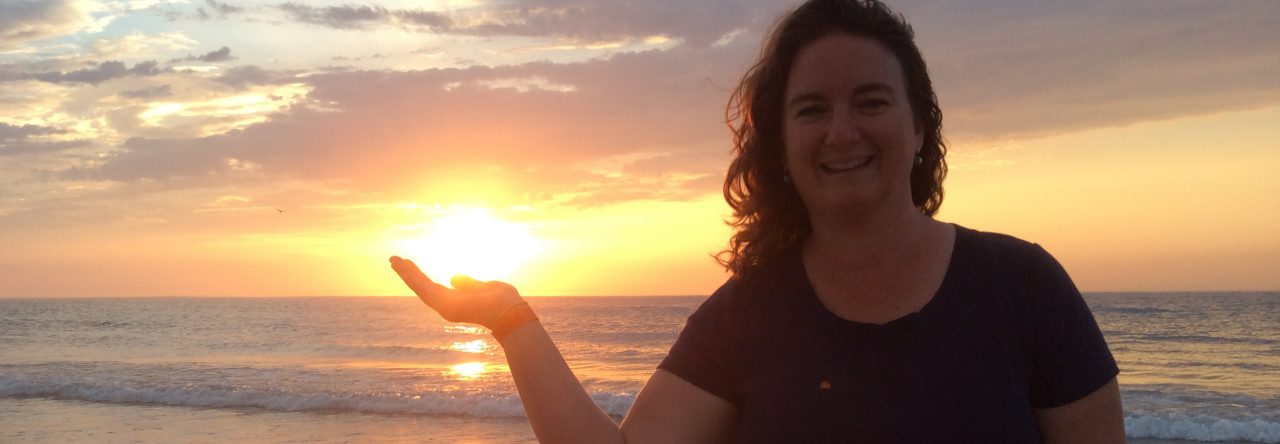Often we see quiet spaces or calm down spaces indoors in early education programs, but what could it look like if created a similar space outdoors? I believe children benefit from having a similar structure in their learning environments, both indoors and in their outdoor classroom. Here are some tips to get you started!
(Do you have pictures of your outdoor quiet space? I’d love it if you share them so I can add a variety of pictures to this blog post!)

Tips on creating your Outdoor Quiet Space:
- Establish a space in your program as a “quiet” place and teach that this is a place a child can go when they need to relax, reset, and calm down.
- In one program they had designated spots outdoors as “Quiet Zones”. They used rope and triangle cloth flags to indicate these spaces (see picture above). This could be an easy way to create multiple areas and children could even help with the creation of flags so they had some feeling of ownership or belonging to the space.
- I often establish a bean pole trellis (see picture below) that is easy to create and affordable. I just set up five bamboo poles that are 6 feet tall. Tie the top and create a trench around the base to plant bean seeds. This is a small enough space that creates some privacy and feels cozy. This same structure could be covered with cloth for similar privacy earlier in the season or when the plants have died off.
- Another affordable space would be to build a simple fort structure. My son built the photo below for an outdoor program in my area. He built a solid main structure and the children added pine branches, other sticks, and leaf debris to create privacy.
- Maybe the space is mobile ~ What about establishing a special “Quiet Chair” ~ perhaps tucked away in the garden or in an area of the Outdoor Classroom that tends to be less busy. Having a folding chair makes it mobile and could give children the options of moving their space or having multiple spaces.
- Reinforce that this is a safe and cozy space that helps us feel calm and safe and that children can choose to go to this space to play alone for a while
- Offer calm down materials, which outdoors might look like a bin that you bring out from storage with a few board books, a non-breakable sensory jar, and various loose parts to explore.
- Post a visual of the calm down technique you use in your program. To make this work outdoors, I laminate the visual and post it on the storage bin so it’s protected from the elements. In my preschool classroom I use the Tucker Turtle Technique. (see resources below)
- Create a durable mini version of books that you use to teach social emotional skills. Lamination can help them last longer and you still may need to replace them yearly.
- Introduce the space during outdoor circle time and model how it is used. For our indoor “Tucker Turtle’s House” we only allow one child to be in the space, but I find this harder to manage outdoors. I would decide with your teaching team if it’s an ‘alone space’ or if a pair can be in there together.
- I tell a lot of social emotional stories with my turtle puppet. There are many life lessons that we can
- Reinforce with simple tales of how turtles see things differently. Moving at their own pace, taking time to tuck & breathe, resting when they need to, have calm and confidence to race a speedy Hare, and the list goes on.
- Work with small groups to practice using the space and revisit it often so children remember why the quiet space is there.
- Reinforce the quiet place when you see them experiencing strong emotions or if a child seems like they need to regroup
- Reinforce to staff that this space is NOT used as a punishment.
- What if your group is on the go? Instead of a designated spot for the quiet space, maybe have a piece of cloth or small portion of yoga mat that serves as a spot that children can go to be alone.
- Our space indoors is a wooden cube, and using more durable materials I can imagine creating something similar outdoors though I have not yet created that myself. (If you have, I’d love to have additional pictures to add to this post!)


Related Resources:

Resources for teaching “Tucker Turtle” from the Pyramid Model / Challenging Behavior
https://challengingbehavior.org/?s=tucker+turtle
Check out Susan Cain’s Ted Talk and Book – “Quiet: The Power of Introverts”
Read more thoughts on my blog post ~ “Private & Quiet Spaces”
